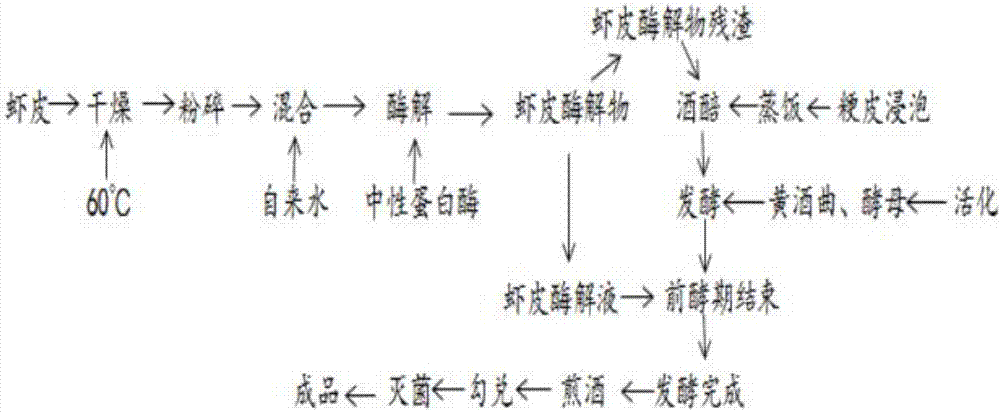Shrimp-taste cooking wine and preparation method thereof
A cooking wine, shrimp flavor technology, applied in the field of fermentation, can solve the problems of low protein and amino acid content, unsuitable for industrial production, poor utilization of raw materials, etc., achieve high utilization of auxiliary materials, high amino acid nitrogen content, improve quality and flavor effect
- Summary
- Abstract
- Description
- Claims
- Application Information
AI Technical Summary
Problems solved by technology
Method used
Image
Examples
Embodiment 1
[0030] A kind of method that utilizes dried shrimps to produce shrimp-flavored cooking wine, such as figure 1 As shown, cooking wine is produced by enzymatically hydrolyzing shrimp skin and mixing the enzymatic hydrolyzate with rice. The specific production steps are as follows:
[0031] 1Kg of shrimp skin is crushed, add 8Kg of hot water at 45°C to soak for 0.5h, stir slowly, under natural pH conditions. Join 8*10 5 U neutral protease, incubate at 45°C for 2 hours, stirring continuously during the period, and obtain the shrimp skin enzymatic hydrolyzate after the enzymolysis is completed. After the enzymolyzate is centrifuged, the enzymolyzate and enzymolyzed residue are obtained.
[0032] Weigh 100Kg japonica rice, add tap water to soak (the water surface should not cover the japonica rice) for 48 hours, drain the water, and steam the rice with a high-pressure rice steamer. After steaming the rice, quickly add 80kg of cold boiled water to the rice, add 0.8Kg of the above-...
Embodiment 2
[0035] 0.5Kg shrimp skins are crushed, add 2.5Kg 45℃ hot water to soak for 0.5h, stir slowly, under natural pH conditions, add 2.5*10 5 U neutral protease, incubate at 45°C for 2h, stirring constantly during this period. After the enzymolysis is finished, the shrimp skin enzymatic hydrolyzate is obtained. After the enzymolyzate is centrifuged, the enzymolyzate and enzymolyzed residue are obtained.
[0036]Weigh 100Kg japonica rice, soak in tap water for 48 hours, drain the water, and steam the rice with a high-pressure rice steamer. After steaming the rice, quickly add 120kg of cold boiled water to the rice, add 0.25Kg of the above-mentioned shrimp skin enzymatic hydrolyzate residue, add (rice wine) distiller's koji 0.1kg, active dry yeast 0.05Kg (distiller's yeast and active dry yeast need to use 2.5% glucose solution in advance 25°C, activated for 30 minutes), mix well and start fermentation. The 0-5 days of fermentation belong to the pre-fermentation stage, which needs t...
Embodiment 3
[0038] 2.5Kg shrimp skins are crushed, add 25Kg 45 ℃ hot water to soak for 0.5h, stir slowly, under natural pH conditions. Add 2.5*10 6 U neutral protease, incubate at 45°C for 2 hours, stirring continuously during the period, and obtain the shrimp skin enzymatic hydrolyzate after the enzymolysis is completed. After the enzymolyzate is centrifuged, the enzymolyzate and enzymolyzed residue are obtained.
[0039] Weigh 100Kg japonica rice, soak in tap water for 48 hours, drain the water, and steam the rice with a high-pressure rice steamer. After steaming the rice, quickly add 40kg of cold boiled water to the rice, add 2Kg of the residue of the above-mentioned shrimp skin enzymatic hydrolyzate, add 0.5kg of distiller's yeast, and 0.3Kg of active dry yeast (distiller's yeast and active dry yeast need to be activated in advance with 2.5% glucose solution at 25°C. 30min), start fermentation after mixing evenly.
[0040] The 0-5 days of fermentation belong to the pre-fermentation...
PUM
 Login to View More
Login to View More Abstract
Description
Claims
Application Information
 Login to View More
Login to View More - R&D
- Intellectual Property
- Life Sciences
- Materials
- Tech Scout
- Unparalleled Data Quality
- Higher Quality Content
- 60% Fewer Hallucinations
Browse by: Latest US Patents, China's latest patents, Technical Efficacy Thesaurus, Application Domain, Technology Topic, Popular Technical Reports.
© 2025 PatSnap. All rights reserved.Legal|Privacy policy|Modern Slavery Act Transparency Statement|Sitemap|About US| Contact US: help@patsnap.com

